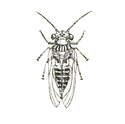Sternorrhyncha
| Sternorrhyncha Temporal range:
| |
|---|---|

| |
| An aphid. | |
| Scientific classification | |
| Domain: | Eukaryota |
| Kingdom: | Animalia |
| Phylum: | Arthropoda |
| Class: | Insecta |
| Order: | Hemiptera |
| Suborder: | Sternorrhyncha |
| Superfamilies | |
|
Aleyrodoidea | |
The Sternorrhyncha[1][2][3] suborder of the Hemiptera contains the aphids, whiteflies, and scale insects, groups which were traditionally included in the now-obsolete order "Homoptera". "Sternorrhyncha" refers to the rearward position of the mouthparts relative to the head.
Distributed worldwide, all members of this group are plant-feeders, many considered pests feeding on major crops and ornamental plants.
Many exhibit modified morphology and/or life cycles, including phenomena such as flightless morphs, parthenogenesis, sexual dimorphism, and eusociality.
Phylogeny
[edit]The phylogeny of the extant Sternorrhyncha, inferred from analysis of small subunit (18S) ribosomal RNA, is shown in the cladogram.[citation needed]
| Sternorrhyncha |
| ||||||||||||||||||||||||
The evolutionary position of several fossil taxa are unclear. A suggested phylogeny is:[4][5]
Groups
[edit]Well-known groups in the Sternorrhyncha include:
- aphids – (Aphididae)
- woolly and gall-making aphids (Eriosomatinae)
- pine and spruce aphids (Adelgidae)
- phylloxerans (Phylloxeridae, including the vine phylloxera)
- whiteflies – (Aleyrodidae)
- jumping plant lice (Psyllidae and allied families)
- Superfamily Coccoidea (scale insects)
- cottony cushion scales, giant coccids, and ground pearls (Margarodidae)
- armoured scales (Diaspididae)
- cochineal insects (Dactylopiidae)
- lac scales (Kerriidae, Lacciferidae, Tachardinidae)
- soft scales (Coccidae)
- pit scales (Asterolecaniidae)
- mealybugs (Pseudococcidae)
- felted scales (Eriococcidae)
References
[edit]- ^ "ITIS standard report - Sternorrhyncha". Integrated Taxonomic Information System. Retrieved 27 July 2014.
- ^ Grimaldi & Engel (2005) Evolution of the Insects 289-303.
- ^ Paraneoptera Species File (Version 5.0/5.0)
- ^ Drohojowska, Jowita; Szwedo, Jacek; Żyła, Dagmara; Huang, Di-Ying; Müller, Patrick (2020). "Fossils reshape the Sternorrhyncha evolutionary tree (Insecta, Hemiptera)". Scientific Reports. 10 (1): 11390. doi:10.1038/s41598-020-68220-x. ISSN 2045-2322. PMC 7347605. PMID 32647332.
- ^ Szwedo, Jacek (2016). "The unity, diversity and conformity of bugs (Hemiptera) through time". Earth and Environmental Science Transactions of the Royal Society of Edinburgh. 107 (2–3): 109–128. Bibcode:2016EESTR.107..109S. doi:10.1017/S175569101700038X. ISSN 1755-6910. S2CID 134243346.




